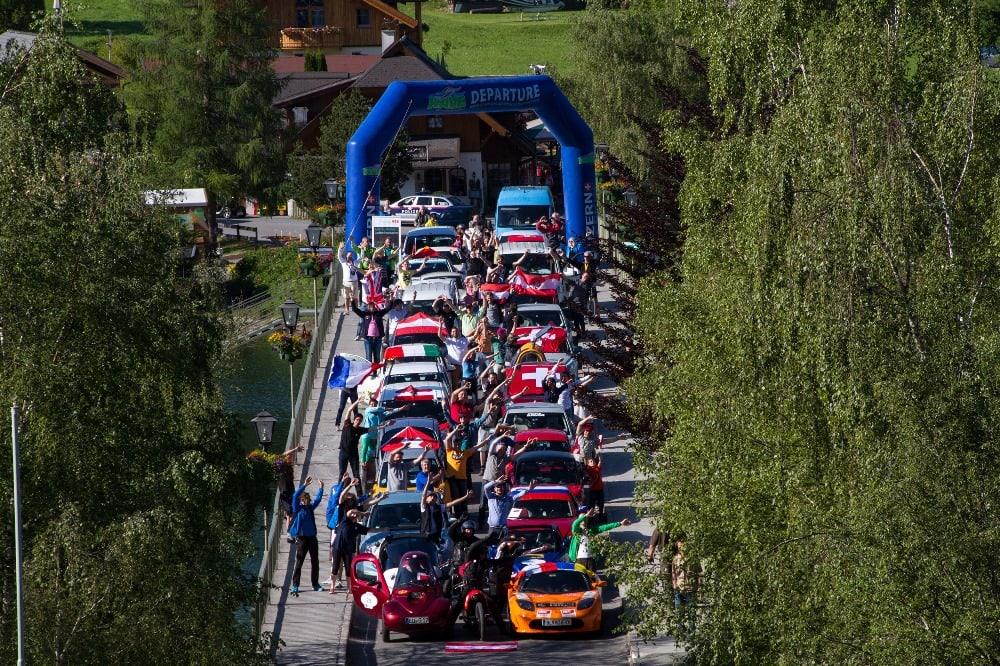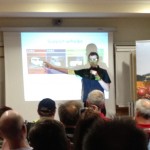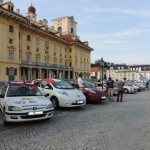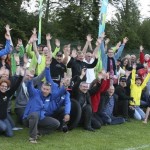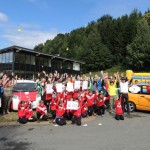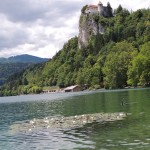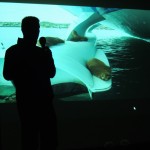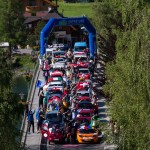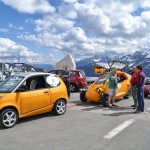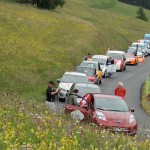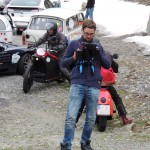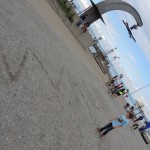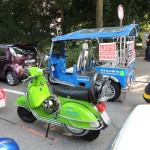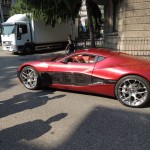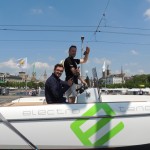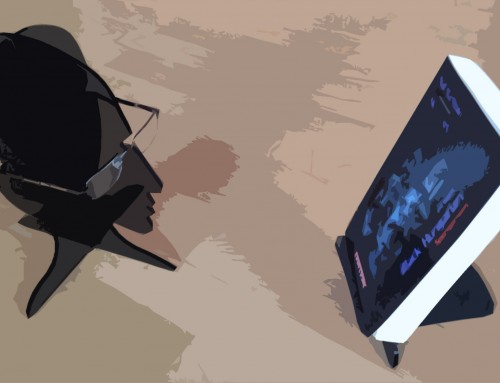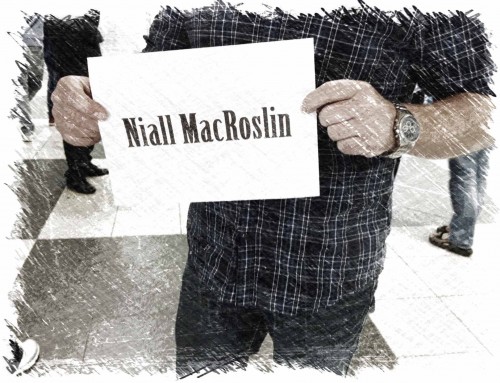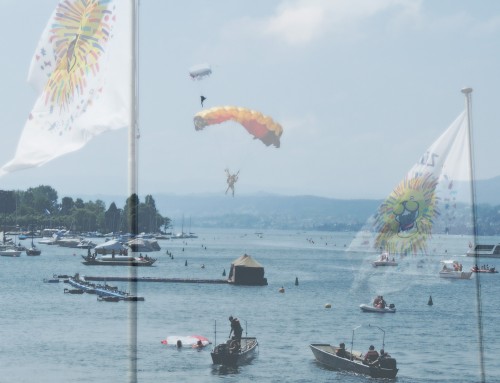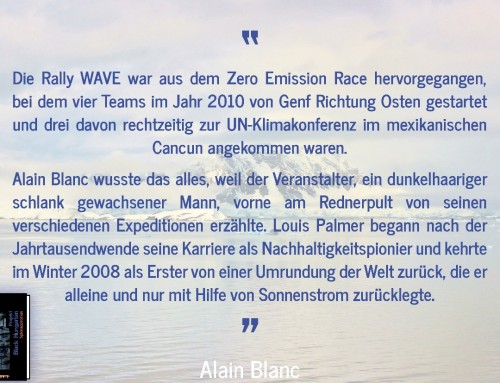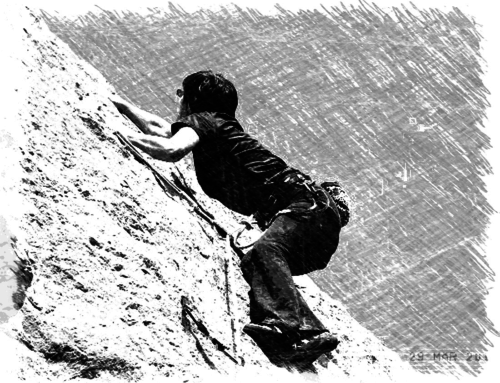He is the first man to travel around the world in a vehicle solely powered by solar energy. The United Nations UNEP awarded him “Champion of the Earth” for inspiration and action.
Louis Palmer’s goal is to rock the boat of conventionally powered transportation and invite more enthusiasts to ride the wave of zero emission driving.
What would he do if he knew that one of his participants is the center of attraction of a ruthless organisation whose boat gets rocked…?
 After travelling the world in his solar taxi for the first time Louis Palmer started out again on an emission-free Zero Race to circumnavigate the world with four teams between August 2010 and February 2011. They were back in Geneva, Switzerland after 80 days and only used electric power.
After travelling the world in his solar taxi for the first time Louis Palmer started out again on an emission-free Zero Race to circumnavigate the world with four teams between August 2010 and February 2011. They were back in Geneva, Switzerland after 80 days and only used electric power.
Next Louis startet the WAVE Trophy in 2011 to spread the message of sustainable and clean travel in Europe. It is the world’s largest electric vehicle rally and typically runs for 10 days ending in Switzerland. World records for the largest electric vehicle parade have been achieved three times. The first record set in downtown Zurich in 2013, also dubbed by some newspapers as the “largest electric vehicle jam”, was followed by a record set at Mercedes Benz Museum in Stuttgart. In 2015 WAVE participants and EV enthusiasts set a new record at the inaugural Formula-E electric race in Berlin Tempelhof.
The third World Advanced Vehicle Expedition, which was to supply the backbone of the story, took place in Europe from the 28th June to the 7th July 2013.
The international group of participants united respected pioneers and globetrotters with dyed-in-the wool enthusiasts, who have already achieved cult-hero status in their respective fields. The majority were taking part for the second or even third time in the hope of achieving their combined aim: to generate enthusiasm for electric vehicles and drive home the importance of protecting our increasingly embattled planet. A visit to the Pasterze glacier at Grossglockner, whose length decreases on a yearly basis, emphasised just how desperately a change of attitude is needed.
During the expedition, the teams driving cars from California-based company Tesla amply demonstrated their technical superiority over models manufactured by the traditional automobile industry; while an equally successful challenge was mounted by a winner of the 2013 Rallye Monte-Carlo des Energies Nouvelles. Along with a number of professionally converted vehicles, whose composition reflected their drivers’ detailed knowledge, the rest of the field was made up by motorcycles and unusual vehicles, each one contributing to the lively atmosphere and sense of camaraderie.
The route took the battery-powered vehicles (any hybrids were obliged to seal their tanks) across the Alps from Vienna to Zurich. Following a punctual start in sunny Eichgraben, it was on through Vienna and Baden – via the casino and its venerable spa gardens – to the state-owned Palace Square in Eisenstadt. Next it was a day of sport. After a night bedevilled by charging difficulties, displays of driving prowess on the test circuit at Gleisdorf alternated with attempts to determine individual vehicles’ load capacity, the latter played out against a backdrop of wildly enthusiastic school pupils at an event in Deutschlandsberg. The following day saw a selection of vehicles attempting to prove their range in a special stage taking in the beautifully situated Slovenian town of Bled. Not even the extensive tasting of the local speciality, vanilla cream-cake, and the fluctuations in weight associated therewith, could prevent the intrepid vehicles from reaching their evening destination.
After an impressive presentation on PlanetSolar, the first solar-powered catamaran to circumnavigate the globe, Weissensee was at its picturesque best the next morning, ensuring that filming of the start – punctual, as ever, to the minute – would take place in perfect weather. Once the last drops of coffee had been served from the battery-powered espresso machine, participants emerged fully-charged (in every sense of the word) to undertake the expedition’s greatest challenge thus far: overcoming the High Alpine Road, a task made even more difficult by the decision of many drivers to visit the glacier at Kaiser Franz-Josefs-Höhe. The route involved an ascent of some 1,400 metres and tested a number of vehicles to the limit. In fact, it was only due to the brave intervention of a Think-driver, who risked his own vehicle in mounting a rescue operation, that all EVs were able to complete this adventure-filled leg of the journey. The longer charging breaks were met without comment by the on-looking marmots; and the charging status of the batteries themselves was shown to be of the utmost relevance, if only in the older EVs. It seems that recuperating energy during braking can prove to be hot work for an already fully-charged battery. Fortunately, keen minds were at hand to make use of the cooling effect provided by the Alpine snow. The next stage was made easier by the effects of a mudslide on the Gerlos Alpine Road, which necessitated a change of route for some drivers. Thereafter, the drive through Innsbruck and Landeck was uneventful. The participants’ attempts at recharging not only their vehicle’s batteries were greatly aided by the extravagant evening buffet in La Punt, where teams were warmly received – as was the case throughout the expedition. The next morning, the field, by now reinvigorated, made their way to a further expedition highlight in the company of a regional TV channel. Their destination: Arosa, via the Albula Pass. Upon arrival, the participants were accorded the red carpet treatment and inspired by the hotel owner’s ambitious plans to expand his already impressive solar energy plant.
The next few days were to prove just as exciting for participants. First, it was a question of stirring the next generation of EV drivers, as teams were asked to deliver one-minute pitches on design and innovation to groups of children in various regional schools. Before the participants themselves became temporary students of material science at EMPA in St. Gallen, an evening stopover by the Bodensee provided them with a warm summer night of leisure. Meanwhile, a presentation by the Chargelocator founder detailing his 80 day voyage around the world in a Tesla Roadster had a number of participants longing for the open road. But even after Baden, where teams were afforded the pleasure of a city tour on e-Bikes, there was still a great deal more to come. The world-record parade, which was held during the Züri Fäscht on the 6th July, was an unforgettable experience for all those who took part: flanked by EVs of all shapes and sizes, the participants, along with some 388 vehicles in total, attempted to create what one wit described as the longest electric vehicle tailback in history. It is still not clear whether the final vehicle – a German e-Boat towed by a battery-powered bus – was counted or not. There was also some speculation as to whether there had ever been more Teslas in the same place at any given time.
After the world-record parade, a number of drivers joined the expedition teams in setting off through the Canton of Zurich for the Tour of Open Doors. In Neuhausen, participants were able to share their memories of the expedition over a glass of wine, as they gazed in wonder at the breath-taking Rhine Falls. Following a trip to the Umweltarena in Spreitenbach, the expedition finally came to an end on Sunday 7th July in Küsnacht. There was a touch of melancholy in the air, and it wasn’t just the youngest participant, at nine years old, who was affected. Existing friendships had been deepened; and new friendships forged. If this expedition proved one thing, it is that open competitions promote development. Charging breaks were an excellent opportunity for participants to make new contacts and exchange experiences. They were also used as a means of obtaining tips, some of which were then surreptitiously applied during later stages of the expedition. However, when push comes to shove, EV pioneers always place the welfare of the group before the success of the individual. The industry would do well to take a leaf out of their book!
Now and then, rumours began to surface about a revolutionary piece of technology being covertly tested at WAVE. There was talk of spies, working on behalf of a Black Hungarian, attempting to ferret out various secrets. The majority, however, were happy to write it off as pure fiction.

